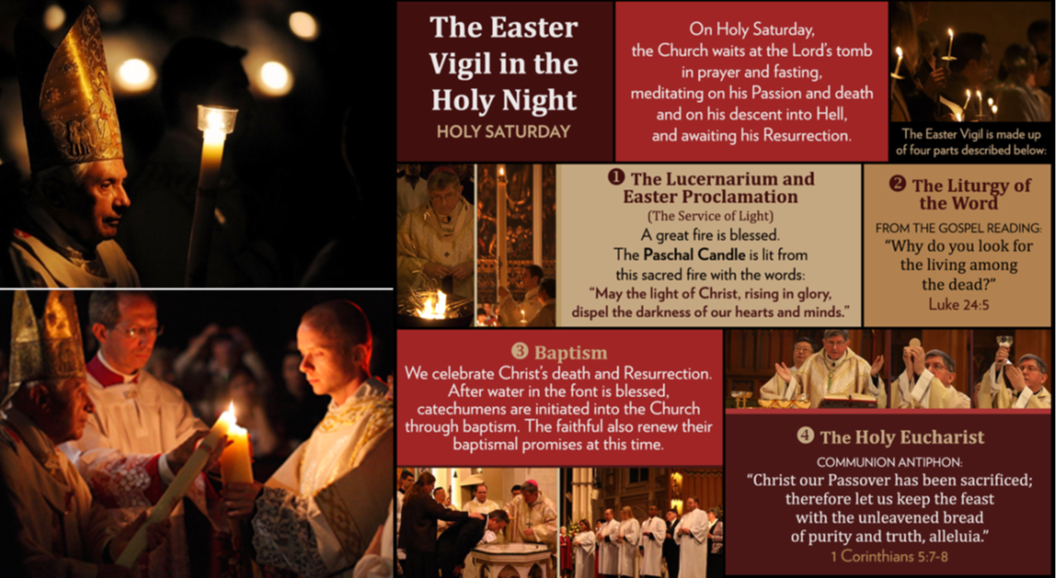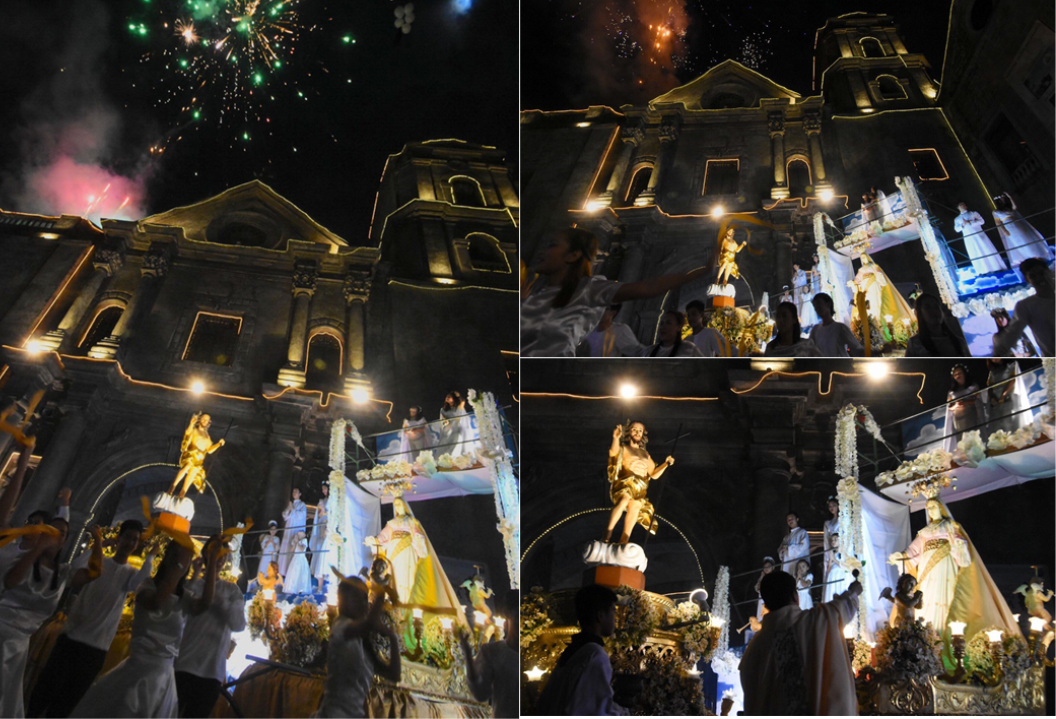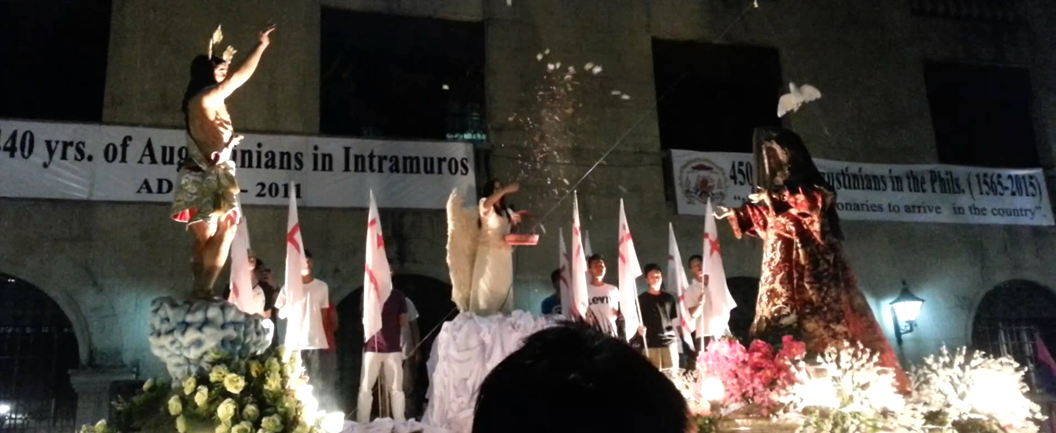
Having just attended my first Easter Vigil Mass in the traditional Latin rite, I felt all the time I was in church how truly blessed I am to be a Catholic and to
participate in such a liturgy. I doubt anyone could improve on the execution of the entire liturgy as it was done at the Church of the Holy Innocents last night.
It is awesome, though it entails about 90 minutes of standing during the opening rituals and the reading (chanting, really) of the twelve prophecies which
recount the history of salvation through the various covenant stages narrated in the Bible. Gregorian chant can be truly mesmerizing, and one could follow it
on the bilingual Mass booklet provided by the church. The Sacred Page blogsite has a beautiful presentation with commentary of these Easter Vigil Readings:
http://www.thesacredpage.com/2018/03/easter-vigil-readings.html
The Easter Vigil Service that continued into the First Easter Mass of the day began at 6 p.m. and ended at around 9:45 p.m. For the first time in a long long
time, I was in a church that was full. Understandable because quite a few Catholics who do not go to Sunday Mass regularly do fulfill their Easter duty
conscientiously. But what struck me was the number of families with children in tow - teenagers to toddlers - so that younger Massgoers (those younger than 40)
easily outnumbered the older folk. And many of the teenagers seemed to have brought their own Missals. A missal is something the Novus Ordo churchgoer
probably has never owned nor needed to own, but for persons like me, my personal missal (I use a Spanish-Latin bilingual missal from the 1950s that my mother
gave me as a birthday present when I was 10), crammed with holy pictures given by friends over the years, is an important part of my personal history...
Communion was overwhelming, with everyone in church taking part, during the one day of the year you cannot imagine anyone approaching the Eucharist
sacrilegiously!... The last hymn we sang in church last night - after the Regina caeli - was an Alleluia hymn that was joyful and lively. It set me thinking why
it is that we do not have Easter carols, when we should, because Easter is supposed to be the Church's most important festival, and what could be more joyful
and glorious than celebrating the Resurrection!
There were no Easter Vigil Masses in my pre-Novus Ordo childhood for the simple reason that in the little provincial capital where I grew up in the Philippines,
the Easter Sunday tradition was a dawn Mass - a Solemn High Mass but without the rituals of the Easter fire and the blessing of the baptismal font and Paschal
candle - that culminated in a procession called '
salubong' (Filipino for 'encounter') that reenacts the first meeting between the Risen Lord and his Mother
(I must confess I never bothered to find out how it originated). Happily, to my surprise, I find some pictures of a
salubong in Manila from today! Which makes
for a relevant digression from what I originally set out to do with this post.
The photos below are of the 'salubong' held on the dawn of April 1, 2018 (Manila is 12 hours ahead of EST) at San Agustin Church in Manila.

 San Agustin church, interior and exterior.
San Agustin church, interior and exterior.
 'Salubong' at San Agustin in 2015. Note the banners about the history of the Augustinians in the Philippines and their historic church.
Quick note about San Agustin church: It is one of four Philippine churches constructed during the Spanish colonial period that were designated as a World Heritage Site by UNESCO. Augustinians were
'Salubong' at San Agustin in 2015. Note the banners about the history of the Augustinians in the Philippines and their historic church.
Quick note about San Agustin church: It is one of four Philippine churches constructed during the Spanish colonial period that were designated as a World Heritage Site by UNESCO. Augustinians were
the first Catholic missionaries in the Philippines, arriving with the Spanish expedition that first settled there in 1565. The original church they built was the first church on Luzon, the main Philippine
island. The present church, on the same site, was completed in 1607, and subsequently survived eight major earthquakes between 1645-1880.
In 1898, the church was the site where the Spanish Governor-General prepared the terms for the surrender of Manila to the United States of America following the Spanish–American War. During the
Japanese occupation of World War II, San Agustin Church became a concentration camp. In the final days of the Battle of Manila, hundreds of residents and clergy were held hostage in the church by
Japanese soldiers with many hostages killed during the three-week-long battle. The church itself was the sole survivor of the seven churches of Intramuros [the walled city that was Spanish colonial
Manila] after the leveling by combined American and Filipino ground forces to flush out remaining Japanese soldiers in May 1945, but its adjoining monastery was completely destroyed. It has since been
rebuilt as a museum.
 A 'salubong' at a suburban parish in Manila, 4/1/18. One of its features is that a girl chosen from a choir of 'angels' in attendance lifts a veil (left) that covers Mary at the time the two statues first face each other.
A 'salubong' at a suburban parish in Manila, 4/1/18. One of its features is that a girl chosen from a choir of 'angels' in attendance lifts a veil (left) that covers Mary at the time the two statues first face each other.
[Modificato da TERESA BENEDETTA 01/04/2018 13:31]